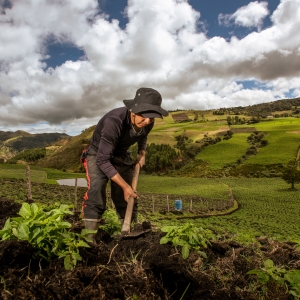There is a significant funding gap for climate adaptation – especially for women. Public financing will not be sufficient to close this gap, but it will be crucial for supporting the most vulnerable and facilitating private sector investments where funding and support is needed most. Inclusive financial systems play an important role in channeling finance to the most vulnerable, including payment systems and last mile agent networks that enable access to social safety net payments, climate risk insurance products, savings for emergencies or affordable credit for investments in climate-resilient assets and more resilient livelihoods. Development funders are thirsty for guidance and good practices to identify where they can be catalytic and crowd in the private sector for greater investment in climate adaptation.
Despite exponential increases in climate funding, too little is being dedicated to climate adaptation in the most vulnerable countries
Where and how funders allocate funding is determined by their organizational strategies and priorities. Over the past two to three years, development funders and many impact investors have adopted strategies focused on addressing climate change and its impacts. More recently, especially after COP26, funders are seeking ways to allocate more funding toward climate adaptation goals. To better understand what funders are doing and whether financial inclusion is leveraged to achieve and accelerate progress toward those goals, CGAP conducted desk research and interviews over the last year (2022-2023). Given the importance of gender equity goals and growing evidence that climate change and public and private sector responses to it are impacting women disproportionally, the research also examined how gender outcomes are embedded into climate strategies and projects. This work covered a range of public and private development funders supporting financial inclusion and/or climate goals.
For climate funding at large, the past decade has seen an exponential increase in climate finance from both public and private sources. Yet far too little of this funding has been dedicated to supporting climate adaptation and resilience. Of the estimated USD 632 billion in climate finance that was committed in 2020, only about 7% was linked to adaptation benefits. And only around USD 83 billion was provided for climate action in low- and middle-income countries (LMICs), meaning that those with the greatest need and fewest resources to adapt are excluded from global climate finance flows.
Public funders have made commitments to fill the financing gap and mobilize private finance by testing and de-risking investments in new business models, technologies, and climate-vulnerable sectors. However, our research showed that many of these funders are still developing strategies and in the early stages of implementing projects and investments that support climate adaptation at scale. We learned that an important barrier funders face in to putting to work their climate adaptation funding commitments is limited knowledge about impact pathways and effective leverage points for advancing climate adaptation and resilience for the most vulnerable.
Four reasons why funders should consider inclusive finance as an opportunity for supporting climate adaptation
Below are four reasons why funders should consider inclusive finance as an opportunity for increasing public and private investments in climate adaptation.
1. Inclusive finance can enable the autonomous adaptation of households
Most climate adaptation projects and investments support planned adaptation strategies at the national level, such as climate-resilient infrastructure and technologies. While important, these programs fall short in supporting households that are already feeling the impact of climate change in reduced crop yields, damaged assets, reduced access to basic services and health-related issues. These households need affordable credit and savings products to access new technologies and skills that enable them to grow more resilient to climate change. In addition, they need risk transfer solutions that protect their investments in case of damage or loss.
2. Inclusive finance can support women’s climate adaptation and resilience
Low-income women are significantly more vulnerable to climate change impacts and therefore in great need to access solutions that help them adapt and build resilience. Research shows that women who can access and use financial services are more likely to be resilient to shocks and stresses, access basic services and run successful businesses. Funders are already including a gender lens in their climate strategies but seem to lack clarity around how they can address both goals simultaneously. Investments in women’s financial inclusion alongside programs for transfer of skills and technologies offer an opportunity for funders to achieve both objectives by empowering women to choose and lead their own adaptation strategies. There is also good experience in the financial inclusion sector about the role of social norms and how to address them, which will be important to consider when designing financial and non-financial solutions for climate adaptation.
3. Inclusive finance can crowd in private sector finance
In 2021, private investors were the primary drivers of financial inclusion funding growth. There is huge interest among private investors in the financial sector and experience among public funders in crowding in more private capital. This opens an opportunity to facilitate existing financial sector investments toward climate adaptation projects. However, this will require public funders to shift their focus (and that of their private peers) away from mitigation-linked projects, to instead demonstrate where there are viable business models and reduce the risk for private investments. Public funders can also help by sharing their data, risk modeling approaches, and learnings that demonstrate the financial and social benefits of investing in climate adaptation.
4. A focus on inclusive finance can enable an inclusive and just transition
There is a risk that the increased focus on greening the financial sector by introducing exclusion lists and requiring green credentials will exclude the most vulnerable from accessing affordable finance. Poor households are in the greatest need to adopt more climate-friendly and resilient practices to maintain and improve their livelihoods. Imposing reporting or certification requirements or excluding them because they are risky clients will prevent them from accessing financial services and limit their ability to adapt and participate in the transition to a more climate-friendly economy. To enable a just transition, there needs to be more awareness and caution to avoid potential financial and economic exclusion of the most vulnerable.
For funders to seize these opportunities and link financial inclusion, climate, and gender goals in their funding practices, they must adopt new processes and shift their internal incentives to take on more risk and work across sectors
Our interviews confirmed that funders are working hard to build their internal capacity and develop targets and metrics to track climate adaptation. However, they were also cognizant that these efforts do not translate into increased projects and funding for climate adaptation unless there are incentives, more concessional and risk-tolerant financial instruments, and an increased exchange of knowledge and good practices. Many funders said that funding mitigation is much easier – there are many sample projects, lessons learned and clear metrics to measure their success against. Funding adaptation is less attractive for funders because it requires them to develop new results chains and metrics, take on risky endeavors that haven’t been tested and invest more in data collection and impact measurement as results are less visible and take time to realize. An encouraging first step, though, is an increased focus on climate adaptation targets which will set milestones and can create incentives to invest more in adaptation projects. Some funders are also integrating climate focal points or creating working groups, including specifically for climate adaptation.
Over the next three years, CGAP will work with investors and financial service providers to identify and test successful approaches to providing financial services that support climate adaptation and resilience. The objective is to share examples, lessons learned and practical guidance for financial services providers, funders and other important sector actors to provide the poor and vulnerable access to financial and non-financial services that support their climate adaptation and resilience. We will convene funders for peer exchange and to jointly develop recommendations as to where public versus private funders may play a more critical role and what financing instruments are most effective in supporting climate adaptation.
To achieve our objectives for this work, we rely on our members and partners to engage and share their experiences. We hope you will join us in this effort. Please reach out or leave a comment below with reactions and suggestions.



